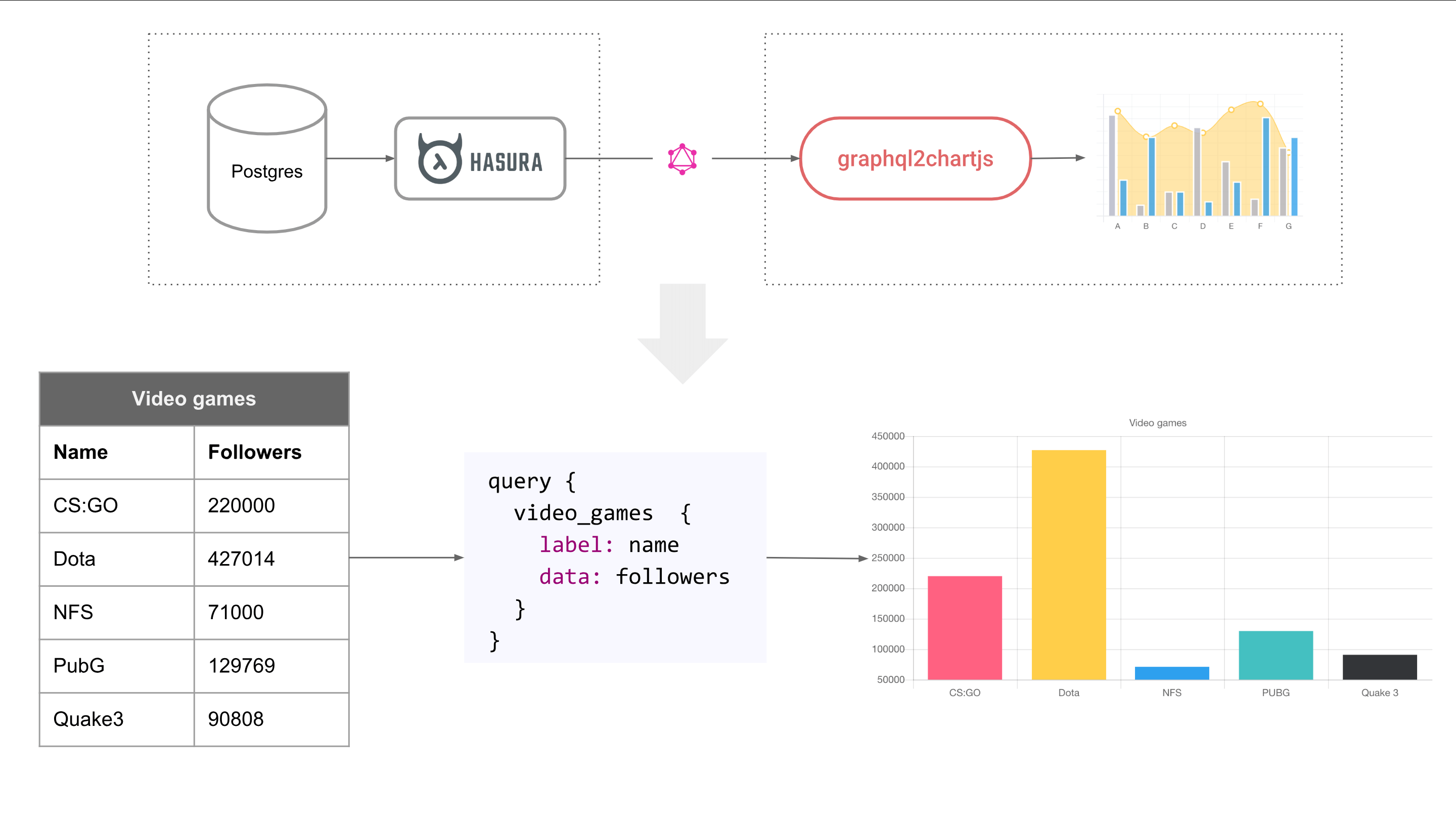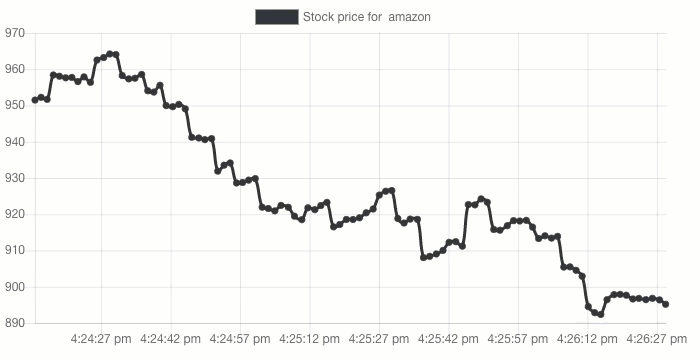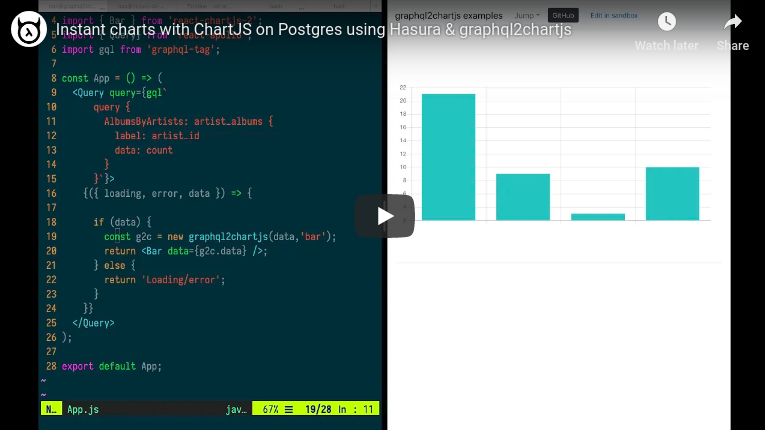graphql2chartjs reshapes your GraphQL data as per the ChartJS API. This makes it easy to query a GraphQL API and render the output as a ChartJS chart.
For example, if you're using Postgres and Hasura, this is what using graphql2chartjs looks like:
We've set up a GraphQL server with continuously changing data, so that you can try graphql2chartjs out easily.
| View live charts | Edit in sandbox | Open GraphiQL |
|---|
The demo above cover the following types of charts: basic, multiple datasets, mixed chart-types, realtime chart with live data, realtime time-series
Hasura gives you an instant realtime GraphQL API on an existing Postgres database. You can create views to capture analytics and aggregations on your database and instantly turn them into charts.
Watch this video below to see a demo/tutorial of using Hasura with an existing Postgres database, creating views and building charts.
import {Query} from 'react-apollo';
import gql from 'graphql-tag';
import graphql2chartjs from 'graphql2chartjs';
import {Bar} from 'react-chartjs-2';
const Chart = () => (
<Query
query={gql`
query {
Articles: articleStats {
label: title
data: num_likes
}
}`}
}>
{({data} => {
if (data) {
const g2c = new graphql2chartjs(data, 'bar');
return (<Bar data={g2c.data} />);
}
return null;
}
</Query>
);Different types of charts need different structures in their datasets.
For example a bar chart dataset needs labels and data associated for each label; the ChartJS API refers to this as label and data. Once you alias fields in your graphql query to label and data, and pass the response through graphql2chartjs, your dataset is ready to be used by bar chart in chartjs.
Charts of this type need 2 data inputs, label and data.
query {
ArticleLikes : articles {
label: title
data: likes
}
}Charts of this type need 2 data inputs: data_x, data_y (and data_r for bubble).
query {
ArticleLikesVsComments : articles {
data_x: num_likes
data_y: num_comments
}
}Charts of this type need 2 data inputs, data_x or data_t and data_y. Note that there is no label.
query {
StockPrices : stockprice {
data_t: created
data_y: price
}
}graphql2chartjs works in 3 steps:
- Initialise graphql2chartjs:
const g2c = new graphql2chartjs() - Add data from your graphql response:
g2c.add(graphqlResponse.data, 'line') - Set your chart data to the data properly of the graphql2chartjs instance:
g2c.data
graphql2chartjs(data, chartType)
const g2c = new graphql2chartjs(data, 'bar');data: This is your GraphQL response. This data should have fieldslabel,dataetc. as per the GraphQL querying described above.chartType: This is a string that represents valid values of what your chart type is. Valid values include'line','bar','radar','doughnut','pie','polarArea','bubble','scatter'.
Notes:
- This is the simplest way of using
graphql2chartjs - If you have multiple datasets, all of the datasets will be rendered automatically as the same type of chart
- To customise the UI options of the rendered chart like colors or to create a mixed type chart (one dataset is rendered as a line chart, another as a bar chart) use the next initialisation method instead of this one.
graphql2chartjs(data, transform)
The transformation function can add chartjs dataset props or even modify the record data:
const g2c = new graphql2chartjs(data, (datasetName, dataPoint) => {
return {
chartType: 'bar',
backgroundColor: 'yellow'
};
});transform(datasetName, dataPoint): This function defined by you can take the name of the dataset and the data record that comes from the GraphQL response and returns an object that can should have thechartTypekey and optionally other keys that specify other dataset properties.- The object returned by this function should look like the following:
{ chartType: 'line', // Or 'line', 'bar', 'radar', 'doughnut', 'pie', 'polarArea', 'bubble', 'scatter' <other keys as per the dataset properties per chart. Refer to the link below> }
chartType: This should be a string value, one of:'line','bar','radar','doughnut','pie','polarArea','bubble','scatter'- Other keys in this object should be dataset properties. These properties are slightly different for different chart types.
- Line chart: https://www.chartjs.org/docs/latest/charts/line.html#dataset-properties
- Bar chart: https://www.chartjs.org/docs/latest/charts/bar.html#dataset-properties
- Radar chart: https://www.chartjs.org/docs/latest/charts/radar.html#dataset-properties
- Doughnut & Pie: https://www.chartjs.org/docs/latest/charts/doughnut.html#dataset-properties
- Polar: https://www.chartjs.org/docs/latest/charts/polar.html#dataset-properties
- Bubble: https://www.chartjs.org/docs/latest/charts/bubble.html#dataset-properties
- Scatter: https://www.chartjs.org/docs/latest/charts/scatter.html#dataset-properties
g2c.data gives you access to the latest ChartJS data that can be passed to your chart.
- Javascript
var myChart = new Chart(ctx, { data: g2c.data });- react-chartjs-2
<Bar data={g2c.data} />g2c.add()
Once you've initialised a graphql2chartjs object, you can use the add function to add data for the first time or incrementally:
await data = runQuery(..);
// Add for a chart type
g2c.add(data, 'line');
// Add with a transformation function to change UI props for the new data added or udpated
g2c.add(data, (datasetName, dataPoint) => {
chartType: 'line',
pointBackgroundColor: 'yellow'
});npm install --save graphql2chartjs
<script src="https://storage.googleapis.com/graphql-engine-cdn.hasura.io/tools/graphql2chartjs/index.js" type="application/javascript"></script>You can reform the existing data in your graphql2chartjs instance using the reform function that takes a reformer function as an argument. This reformer function is run over every datapoint in every dataset. For instance, to scale the x and y coordinates, you would do something like:
g2c.reform((datasetName, dataPoint) => {
// scale the x, y coordinates
return {
data_x: scalingFactor(dataPoint.data_x),
data_y: scalingFactor(dataPoint.data_y)
}
})


